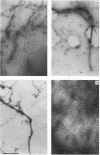Abstract
We propose that, in the cell, the reversible conversion of actin filaments into actin bundles is controlled by the concentration of the macromolecules [we have employed poly(ethylene glycol) 6000 to mimic the macromolecules of the cell] as well as by the nature of the ancillary cytoskeletal proteins that decorate actin filaments. The proposal is based on the following evidence. (1) Under our experimental conditions the transition from filaments into bundles occurs at increasing concentrations of poly(ethylene glycol), with the following sequence: caldesmon-actin, 3%; filamin-actin, 4-5%; caldesmon-tropomyosin-actin, 5-7%; actin, 6-7%; tropomyosin-actin, 9-10%. (2) Under conditions of low osmoelastic stress [3% poly(ethylene glycol)], preformed caldesmon-actin bundles are dissociated by the addition of either tropomyosin or tropomyosin-decorated actin. The dissociation of the bundles promoted by the addition of tropomyosin-decorated actin is faster than that promoted by the addition of tropomyosin.
Full text
PDF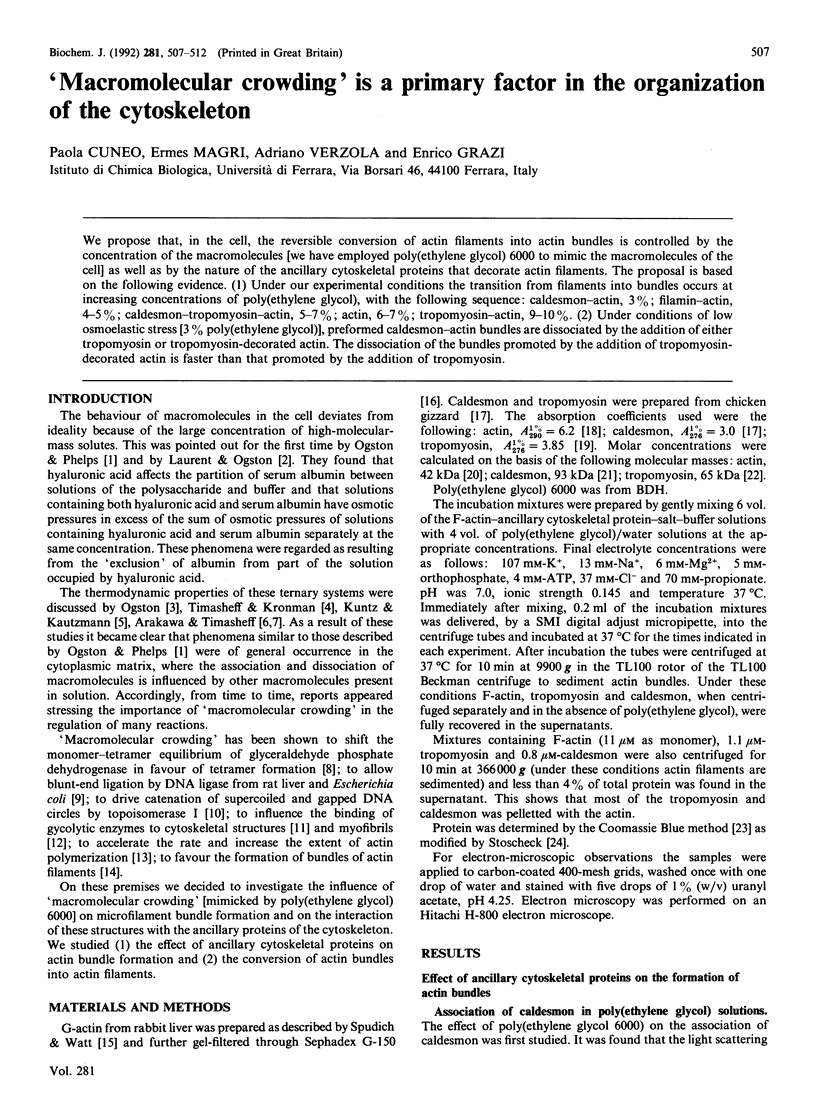
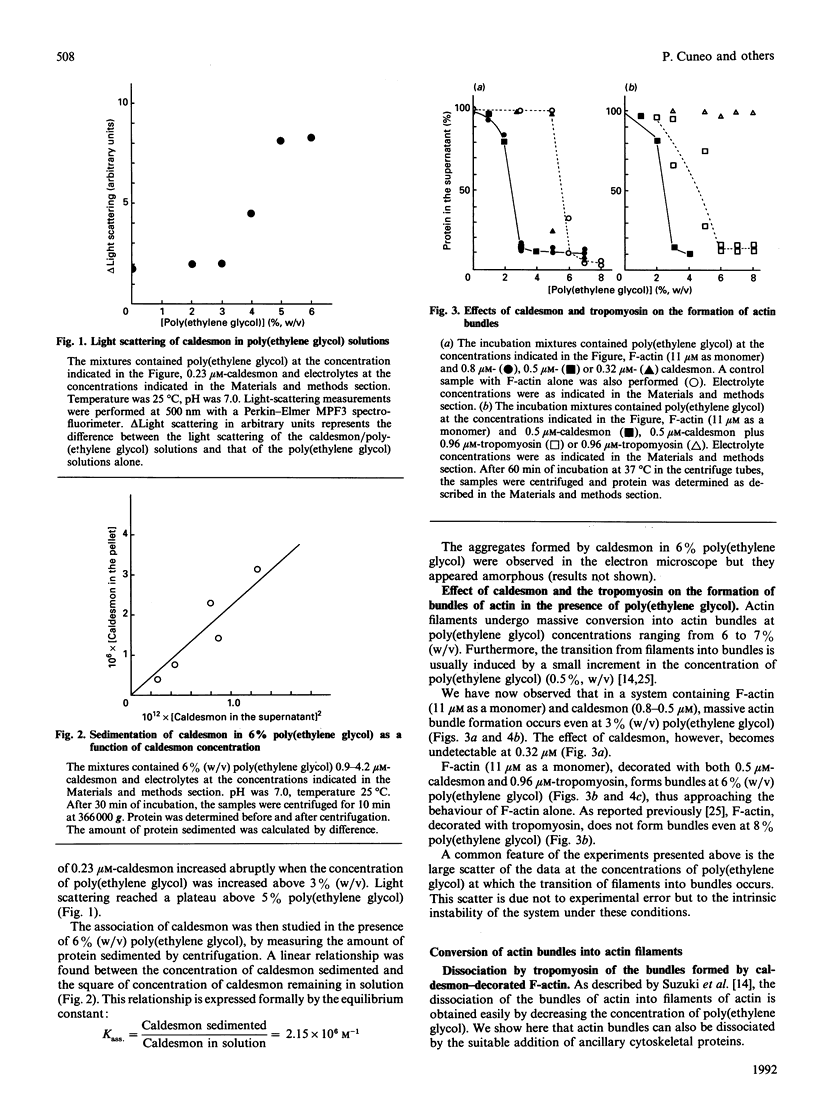
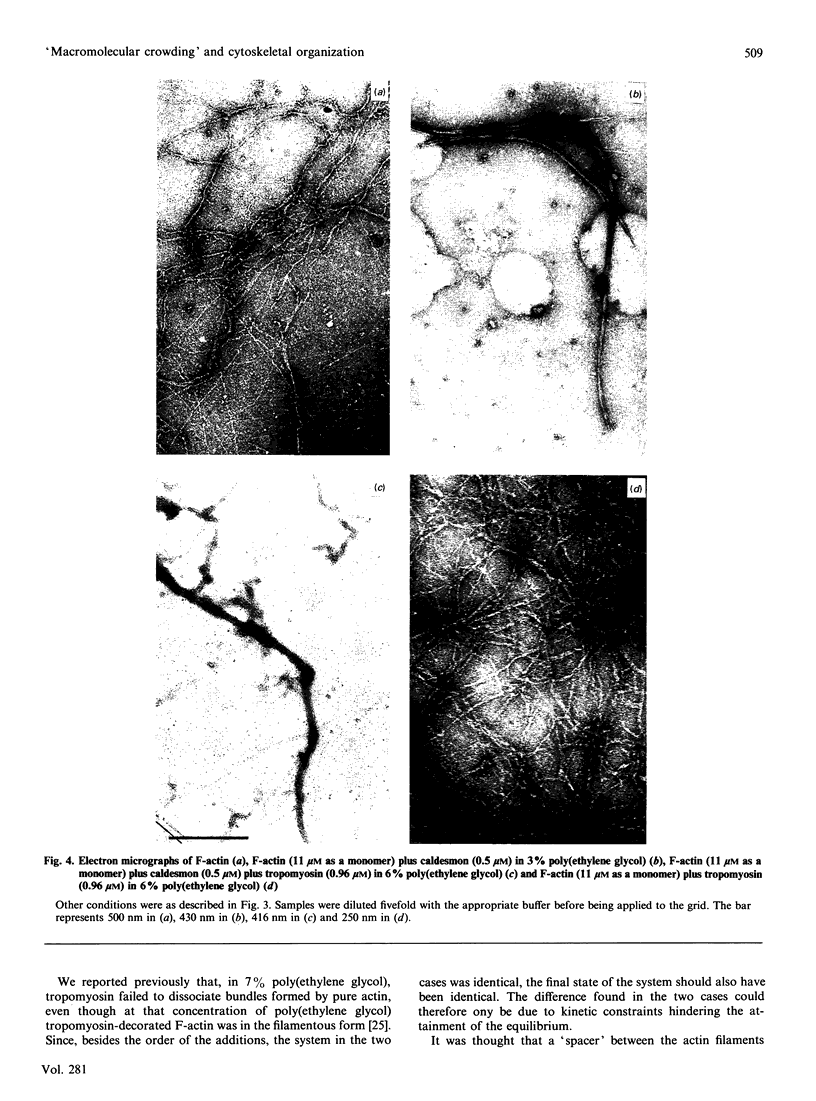
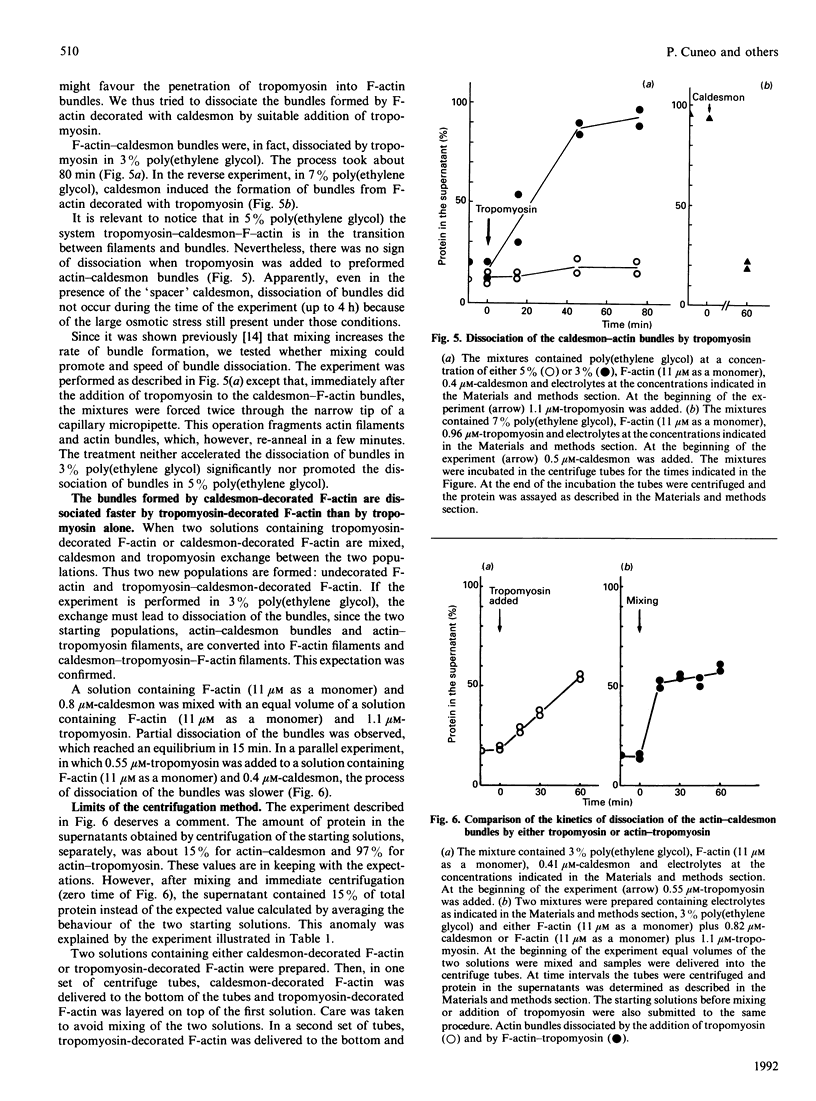
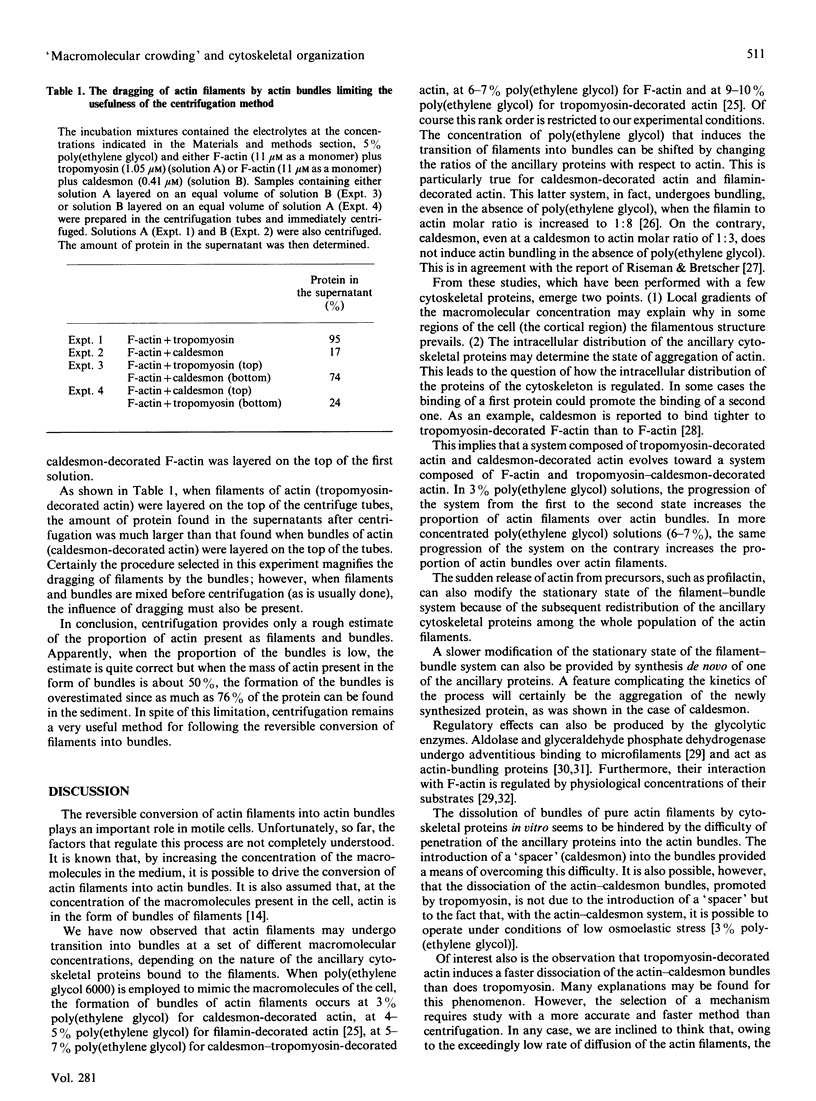
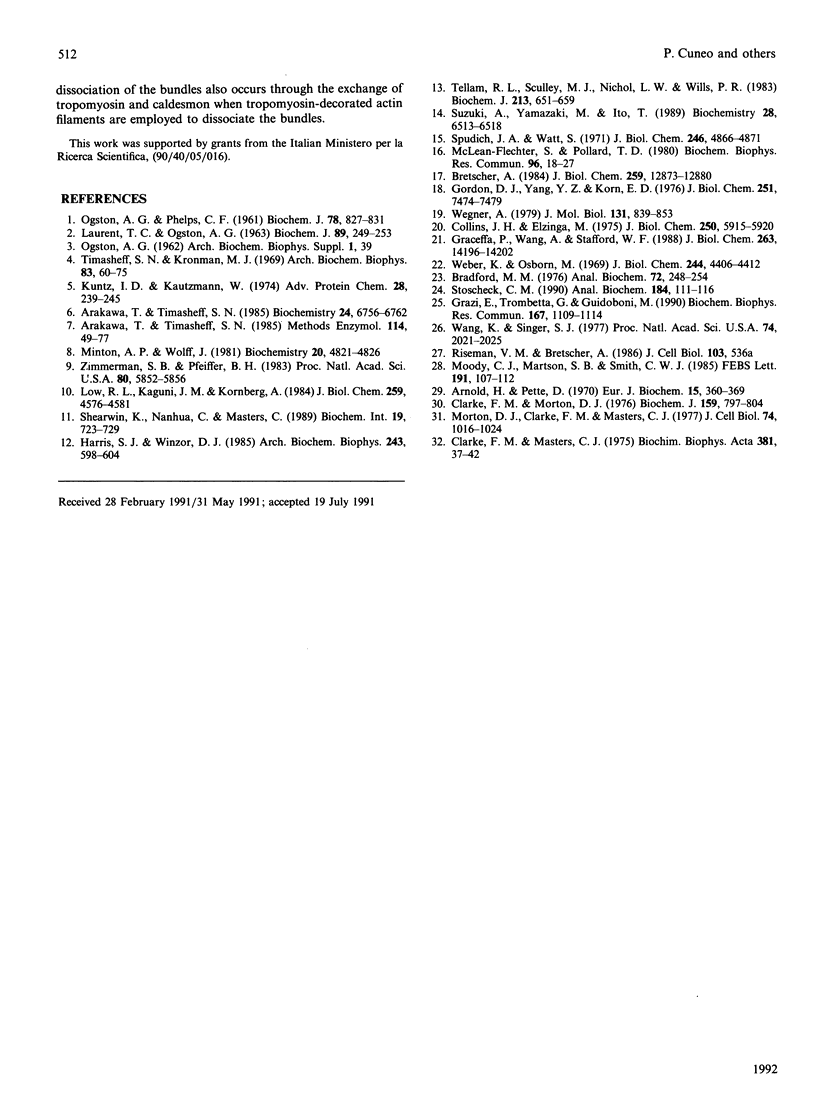
Images in this article
Selected References
These references are in PubMed. This may not be the complete list of references from this article.
- Arakawa T., Timasheff S. N. Mechanism of poly(ethylene glycol) interaction with proteins. Biochemistry. 1985 Nov 19;24(24):6756–6762. doi: 10.1021/bi00345a005. [DOI] [PubMed] [Google Scholar]
- Arakawa T., Timasheff S. N. Theory of protein solubility. Methods Enzymol. 1985;114:49–77. doi: 10.1016/0076-6879(85)14005-x. [DOI] [PubMed] [Google Scholar]
- Arnold H., Pette D. Binding of aldolase and triosephosphate dehydrogenase to F-actin and modification of catalytic properties of aldolase. Eur J Biochem. 1970 Aug;15(2):360–366. doi: 10.1111/j.1432-1033.1970.tb01016.x. [DOI] [PubMed] [Google Scholar]
- Bradford M. M. A rapid and sensitive method for the quantitation of microgram quantities of protein utilizing the principle of protein-dye binding. Anal Biochem. 1976 May 7;72:248–254. doi: 10.1016/0003-2697(76)90527-3. [DOI] [PubMed] [Google Scholar]
- Bretscher A. Smooth muscle caldesmon. Rapid purification and F-actin cross-linking properties. J Biol Chem. 1984 Oct 25;259(20):12873–12880. [PubMed] [Google Scholar]
- Clarke F. M., Masters C. J. On the association of glycolytic enzymes with structural proteins of skeletal muscle. Biochim Biophys Acta. 1975 Jan 13;381(1):37–46. doi: 10.1016/0304-4165(75)90187-7. [DOI] [PubMed] [Google Scholar]
- Clarke F. M., Morton D. J. Aldolase binding to actin-containing filaments. Formation of paracrystals. Biochem J. 1976 Dec 1;159(3):797–798. doi: 10.1042/bj1590797. [DOI] [PMC free article] [PubMed] [Google Scholar]
- Collins J. H., Elzinga M. The primary structure of actin from rabbit skeletal muscle. Completion and analysis of the amino acid sequence. J Biol Chem. 1975 Aug 10;250(15):5915–5920. [PubMed] [Google Scholar]
- Gordon D. J., Yang Y. Z., Korn E. D. Polymerization of Acanthamoeba actin. Kinetics, thermodynamics, and co-polymerization with muscle actin. J Biol Chem. 1976 Dec 10;251(23):7474–7479. [PubMed] [Google Scholar]
- Graceffa P., Wang C. L., Stafford W. F. Caldesmon. Molecular weight and subunit composition by analytical ultracentrifugation. J Biol Chem. 1988 Oct 5;263(28):14196–14202. [PubMed] [Google Scholar]
- Grazi E., Trombetta G., Guidoboni M. Divergent effects of filamin and tropomyosin on actin filaments bundling. Biochem Biophys Res Commun. 1990 Mar 30;167(3):1109–1114. doi: 10.1016/0006-291x(90)90637-3. [DOI] [PubMed] [Google Scholar]
- Harris S. J., Winzor D. J. Effect of thermodynamic nonideality on the subcellular distribution of enzymes: adsorption of aldolase to muscle myofibrils. Arch Biochem Biophys. 1985 Dec;243(2):598–604. doi: 10.1016/0003-9861(85)90537-5. [DOI] [PubMed] [Google Scholar]
- Kuntz I. D., Jr, Kauzmann W. Hydration of proteins and polypeptides. Adv Protein Chem. 1974;28:239–345. doi: 10.1016/s0065-3233(08)60232-6. [DOI] [PubMed] [Google Scholar]
- LAURENT T. C., OGSTON A. G. THE INTERACTION BETWEEN POLYSACCHARIDES AND OTHER MACROMOLECULES. 4. THE OSMOTIC PRESSURE OF MIXTURES OF SERUM ALBUMIN AND HYALURONIC ACID. Biochem J. 1963 Nov;89:249–253. doi: 10.1042/bj0890249. [DOI] [PMC free article] [PubMed] [Google Scholar]
- Low R. L., Kaguni J. M., Kornberg A. Potent catenation of supercoiled and gapped DNA circles by topoisomerase I in the presence of a hydrophilic polymer. J Biol Chem. 1984 Apr 10;259(7):4576–4581. [PubMed] [Google Scholar]
- MacLean-Fletcher S., Pollard T. D. Identification of a factor in conventional muscle actin preparations which inhibits actin filament self-association. Biochem Biophys Res Commun. 1980 Sep 16;96(1):18–27. doi: 10.1016/0006-291x(80)91175-4. [DOI] [PubMed] [Google Scholar]
- Minton A. P., Wilf J. Effect of macromolecular crowding upon the structure and function of an enzyme: glyceraldehyde-3-phosphate dehydrogenase. Biochemistry. 1981 Aug 18;20(17):4821–4826. doi: 10.1021/bi00520a003. [DOI] [PubMed] [Google Scholar]
- Moody C. J., Marston S. B., Smith C. W. Bundling of actin filaments by aorta caldesmon is not related to its regulatory function. FEBS Lett. 1985 Oct 21;191(1):107–112. doi: 10.1016/0014-5793(85)81003-6. [DOI] [PubMed] [Google Scholar]
- Morton D. J., Clarke F. M., Masters C. J. An electron microscope study of the interaction between fructose diphosphate aldolase and actin-containing filaments. J Cell Biol. 1977 Sep;74(3):1016–1023. doi: 10.1083/jcb.74.3.1016. [DOI] [PMC free article] [PubMed] [Google Scholar]
- OGSTON A. G., PHELPS C. F. The partition of solutes between buffer solutions and solutions containing hyaluronic acid. Biochem J. 1961 Apr;78:827–833. doi: 10.1042/bj0780827. [DOI] [PMC free article] [PubMed] [Google Scholar]
- Shearwin K., Nanhua C., Masters C. The influence of molecular crowding on the binding of glycolytic enzymes to cytoskeletal structure. Biochem Int. 1989 Oct;19(4):723–729. [PubMed] [Google Scholar]
- Spudich J. A., Watt S. The regulation of rabbit skeletal muscle contraction. I. Biochemical studies of the interaction of the tropomyosin-troponin complex with actin and the proteolytic fragments of myosin. J Biol Chem. 1971 Aug 10;246(15):4866–4871. [PubMed] [Google Scholar]
- Stoscheck C. M. Increased uniformity in the response of the coomassie blue G protein assay to different proteins. Anal Biochem. 1990 Jan;184(1):111–116. doi: 10.1016/0003-2697(90)90021-z. [DOI] [PubMed] [Google Scholar]
- Suzuki A., Yamazaki M., Ito T. Osmoelastic coupling in biological structures: formation of parallel bundles of actin filaments in a crystalline-like structure caused by osmotic stress. Biochemistry. 1989 Jul 25;28(15):6513–6518. doi: 10.1021/bi00441a052. [DOI] [PubMed] [Google Scholar]
- TIMASHEFF S. N., KRONMAN M. J. The extrapolation of light-scattering data to zero concentration. Arch Biochem Biophys. 1959 Jul;83(1):60–75. doi: 10.1016/0003-9861(59)90010-4. [DOI] [PubMed] [Google Scholar]
- Tellam R. L., Sculley M. J., Nichol L. W., Wills P. R. The influence of poly(ethylene glycol) 6000 on the properties of skeletal-muscle actin. Biochem J. 1983 Sep 1;213(3):651–659. doi: 10.1042/bj2130651. [DOI] [PMC free article] [PubMed] [Google Scholar]
- Wang K., Singer S. J. Interaction of filamin with f-actin in solution. Proc Natl Acad Sci U S A. 1977 May;74(5):2021–2025. doi: 10.1073/pnas.74.5.2021. [DOI] [PMC free article] [PubMed] [Google Scholar]
- Weber K., Osborn M. The reliability of molecular weight determinations by dodecyl sulfate-polyacrylamide gel electrophoresis. J Biol Chem. 1969 Aug 25;244(16):4406–4412. [PubMed] [Google Scholar]
- Wegner A. Equilibrium of the actin-tropomyosin interaction. J Mol Biol. 1979 Jul 15;131(4):839–853. doi: 10.1016/0022-2836(79)90204-3. [DOI] [PubMed] [Google Scholar]
- Zimmerman S. B., Pheiffer B. H. Macromolecular crowding allows blunt-end ligation by DNA ligases from rat liver or Escherichia coli. Proc Natl Acad Sci U S A. 1983 Oct;80(19):5852–5856. doi: 10.1073/pnas.80.19.5852. [DOI] [PMC free article] [PubMed] [Google Scholar]



